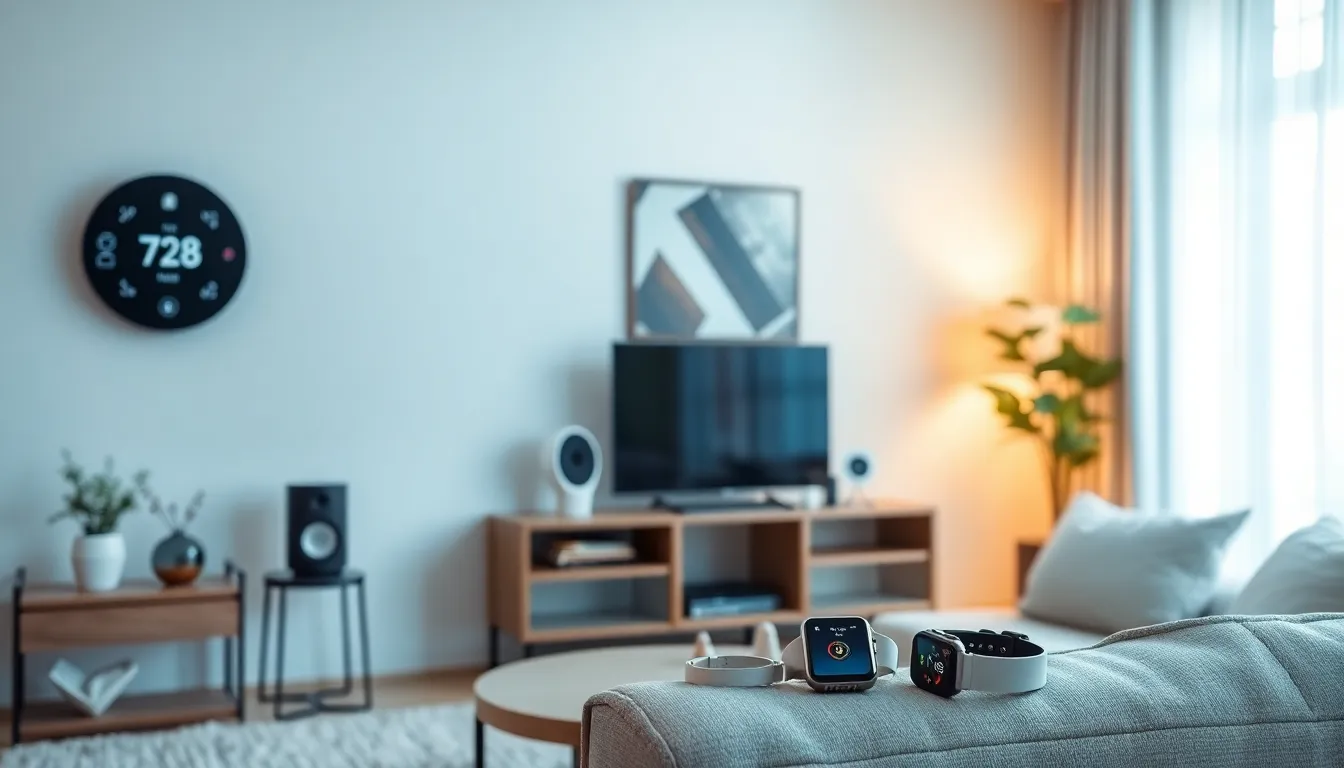Table of Contents
ToggleIn a world where smartphones are practically an extension of our arms and smart fridges can remind us to buy milk, hi-tech and consumer electronics have become the heartbeat of modern life. From gadgets that make life easier to those that simply make it cooler, technology is evolving at lightning speed. If you think your toaster is high-tech because it has a browning control, wait until you see what’s next!
Overview of Hi-Tech & Consumer Electronics
Hi-tech consumer electronics encompass a wide range of devices designed for enhanced everyday living. Devices such as smartphones, tablets, and laptops serve as central hubs for communication, entertainment, and productivity. Continuous advancements in technology drive the development of smarter features, elevating user experiences.
Smart home devices play a significant role in this landscape. Thermostats, security cameras, and smart speakers enable users to control their environments with ease. Integration of artificial intelligence in these devices improves functionality, allowing for voice activation and automated routines.
Wearable technology also contributes significantly to the hi-tech consumer electronics market. Items like smartwatches and fitness trackers provide real-time health monitoring and connectivity to smartphones. Users benefit from insights into their well-being, encouraging healthier lifestyles.
Gaming consoles continue to evolve, offering high-definition graphics and immersive experiences. The addition of virtual reality creates opportunities for gamers to interact with digital worlds in unprecedented ways. Access to vast libraries of games ensures that entertainment options remain diverse.
Emerging technologies, such as augmented reality and 5G connectivity, promise substantial shifts in consumer electronics. Augmented reality applications expand possibilities in education and training. Enhanced mobile connectivity plays a crucial role in enabling faster downloads and seamless streaming for users on the go.
Consequently, the intersection of these technologies fosters innovation. Consumers eagerly adopt devices that improve quality of life while providing convenience. Automation, personalization, and connectivity define contemporary consumer electronics, shaping future developments in the industry.
Latest Trends in Hi-Tech & Consumer Electronics

Hi-tech and consumer electronics continue to advance rapidly, impacting daily life significantly. Innovations consistently enhance convenience and efficiency across various domains.
Smart Home Devices
Smart home devices play a pivotal role in modern living environments. Products like smart thermostats adjust temperatures automatically to optimize energy usage. Security cameras offer remote monitoring, enhancing safety for families. Voice-activated assistants integrate seamlessly into households, managing tasks like playing music and controlling lights. These devices create interconnected systems that enhance comfort and automation.
Wearable Technology
Wearable technology continues to expand, focusing on health and connectivity. Smartwatches track health metrics such as heart rate, sleep patterns, and activity levels. Fitness trackers enable users to set goals and monitor progress in real time. These devices sync with smartphones, providing notifications and messages at a glance. Enhanced designs improve comfort, making them more appealing for everyday wearable use.
AI-Driven Gadgets
AI-driven gadgets reshape consumer electronics by introducing advanced functionalities. Smart appliances learn user preferences, adjusting operations for energy efficiency and convenience. Voice recognition technologies enhance interaction, allowing users to control devices through simple commands. Personalized recommendations in streaming services illustrate AI’s impact on entertainment choices. As AI continues to evolve, the integration within various gadgets will likely increase, improving user experiences substantially.
Popular Brands in the Industry
The high-tech consumer electronics industry hosts a range of prominent brands making significant impacts on technology. From innovative startups to renowned giants, each company shapes the market landscape.
Emerging Companies
Emerging companies are redefining consumer electronics through unique products and revolutionary approaches. For instance, brands like Nothing and Anker focus on design and utility, offering distinct experiences compared to traditional methods. Recent entrants, such as Fairphone, emphasize sustainability while ensuring functionality, appealing to eco-conscious consumers. Another notable company, Fenix, concentrates on smart gadgets that enhance daily tasks, merging technology with practicality. Each of these new players introduces fresh perspectives and drives competition, fostering innovation among established brands.
Established Leaders
Established leaders continue to dominate the hi-tech consumer electronics market through relentless innovation and diverse offerings. Companies like Apple and Samsung lead with smartphones that boast advanced features and sleek designs, catering to a wide range of users. Sony stands out in the gaming console space, consistently delivering high-quality experiences and immersive technology. Meanwhile, LG’s reputation for smart home devices ensures consumers receive functional, stylish solutions for modern living. These industry stalwarts leverage their resources to shape trends while maintaining customer loyalty through reliable performance and cutting-edge advancements.
Consumer Buying Guide
Navigating the world of hi-tech consumer electronics requires understanding essential features and budget considerations. This guide helps consumers make informed choices in a complex market.
Key Features to Consider
When selecting consumer electronics, several features enhance user experience. First, the display quality impacts visuals significantly. If clarity and color accuracy matter, look for devices with high-resolution screens. Battery life plays a crucial role; longer-lasting batteries lead to extended usage without interruptions. Connectivity options offer versatility; devices equipped with Bluetooth and Wi-Fi capabilities provide seamless pairing and internet access. Storage capacity should be scrutinized, especially for those who store large amounts of data. Lastly, user compatibility and intuitive design stand out; products that offer ease of use significantly improve satisfaction.
Price Range Expectations
Understanding price ranges helps set realistic budgets for tech purchases. Entry-level smartphones typically range from $200 to $400, while mid-tier options fall between $400 and $800. High-end models can exceed $1,000, delivering cutting-edge technology. For laptops, budget-friendly choices might start around $300, with mid-range devices costing between $500 and $1,000. Premium laptops, often featuring advanced specifications, are priced over $1,000. Wearable technology also varies; fitness trackers can be purchased for $50 to $100, while smartwatches range from $150 to $800 based on features. Expect emerging trends and innovations to affect prices, with new models entering the market frequently.
Future of Hi-Tech & Consumer Electronics
Advancements in hi-tech consumer electronics are driving innovation across multiple domains. Smart home ecosystems are integrating even more seamlessly, enhancing user control and comfort through interconnected devices. Artificial intelligence continues to play a crucial role, making gadgets smarter and more responsive to individual preferences.
Trends in wearable technology suggest further focus on health monitoring and connectivity. Expect to see more devices equipped with advanced sensors that track vital health metrics. Additionally, augmented reality and virtual reality technologies are poised to redefine entertainment and training landscapes, creating immersive environments for users.
Gaming consoles are adapting to these shifts, incorporating high-definition graphics and real-time capabilities for an unparalleled gaming experience. Cloud gaming is also emerging, allowing users to stream games directly without the need for powerful hardware.
The competitive environment in the industry remains dynamic. Notable brands like Apple, Samsung, and Sony are continuously innovating to maintain their market leadership. Concurrently, new players such as Nothing and Fairphone emphasize sustainability while offering unique products that capture consumer interest.
Consumer preferences dictate features that matter most. Display quality, battery life, and connectivity options are at the forefront of purchase decisions. Value expectations inform choices, with entry-level smartphones ranging from $200 to $400 and high-end models often exceeding $1,000.
The future landscape will focus on delivering personalized experiences through AI-driven functionalities, automation, and enhanced connectivity. As consumers engage with these technologies, the evolution of hi-tech consumer electronics shapes how they interact with their world daily.
The landscape of high-tech consumer electronics is evolving at an unprecedented pace. As technology continues to integrate into daily life, consumers can expect even greater convenience and innovation. The rise of smart home devices and wearable technology is just the beginning of a transformative journey that prioritizes user experience and connectivity.
Emerging trends are set to redefine how people interact with their gadgets, making everyday tasks simpler and more efficient. With a competitive market driving advancements, both established brands and newcomers are poised to create products that not only meet but exceed consumer expectations. This dynamic environment promises a future where technology enhances lifestyles in ways previously unimaginable.





